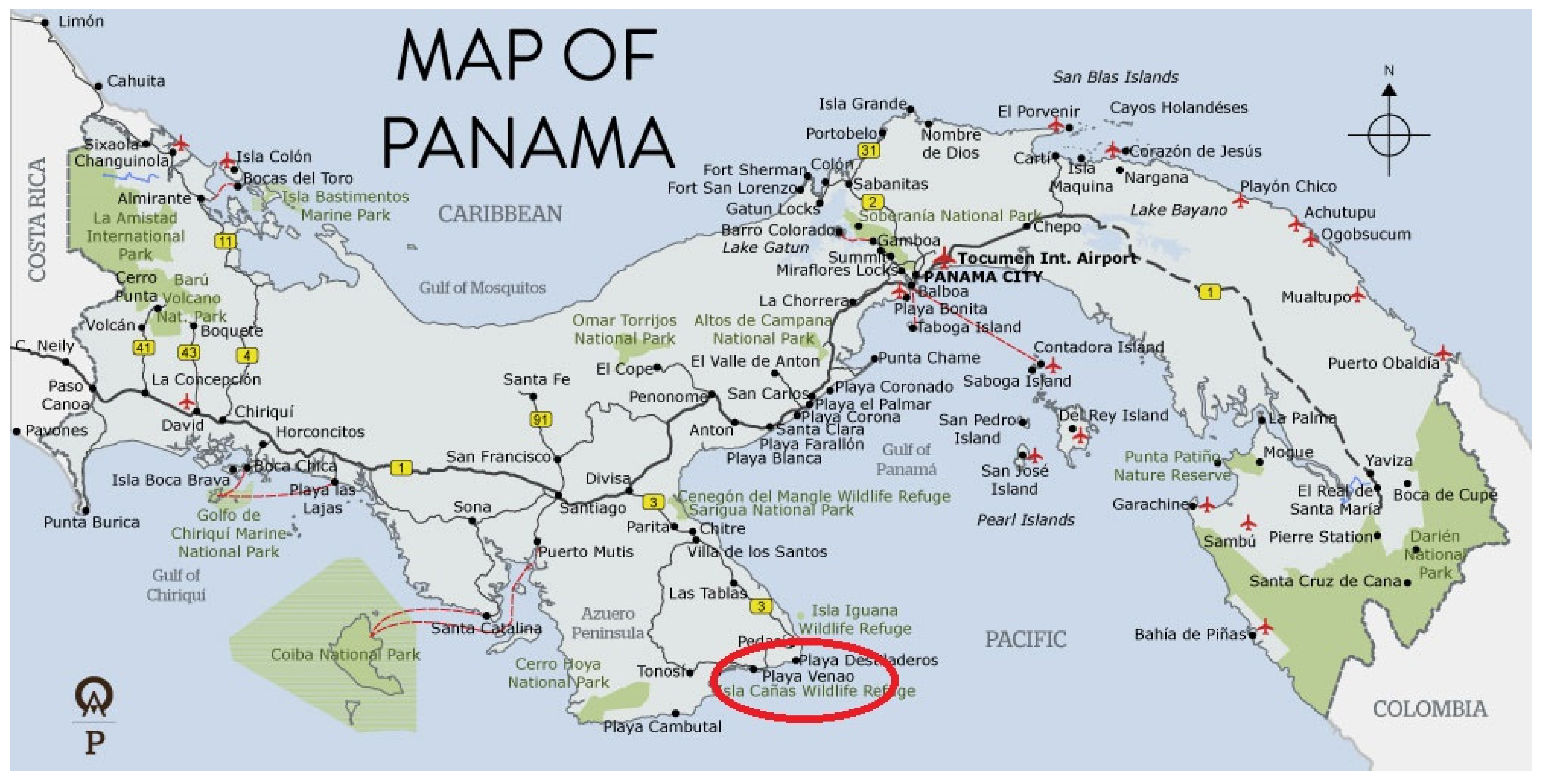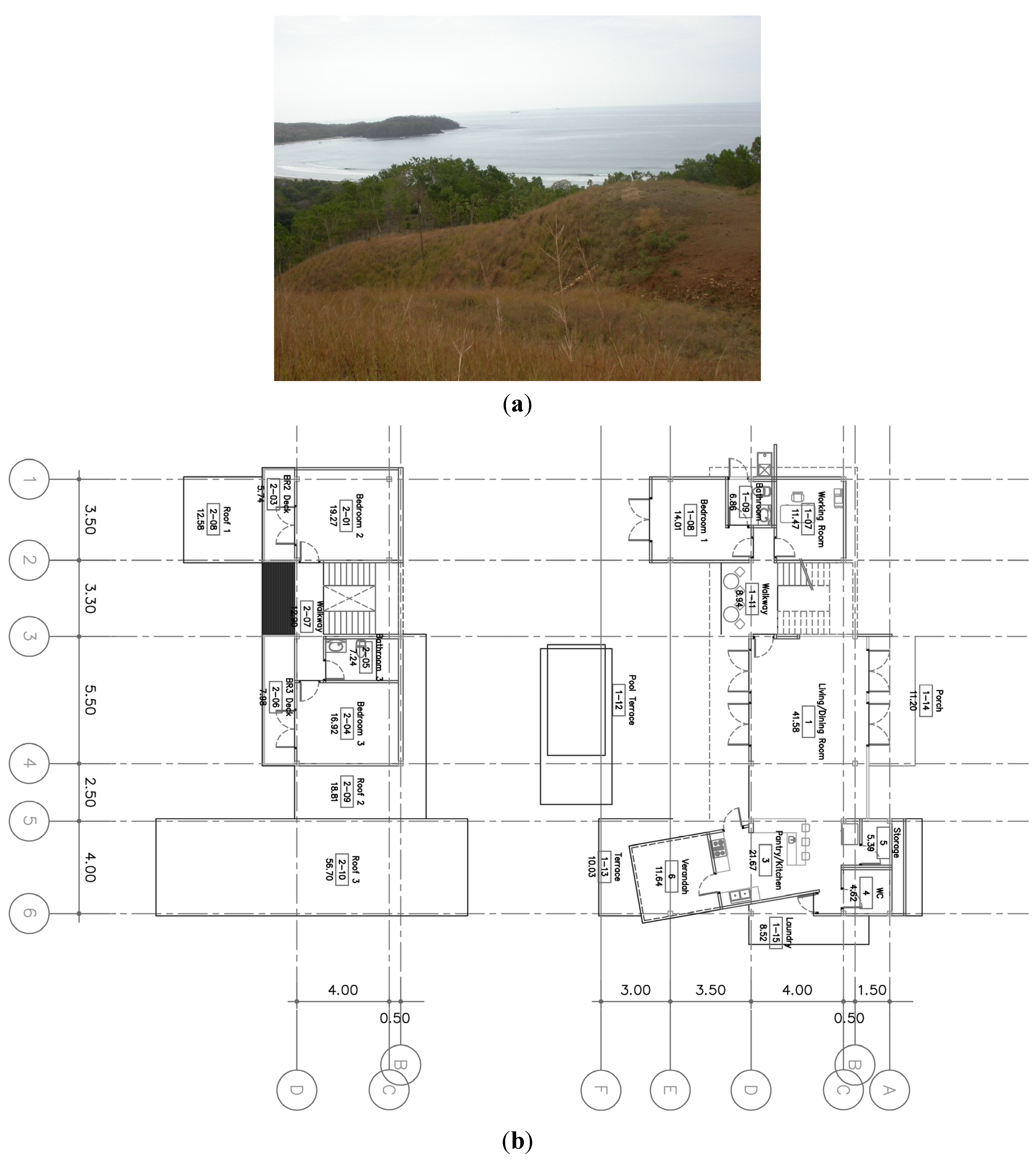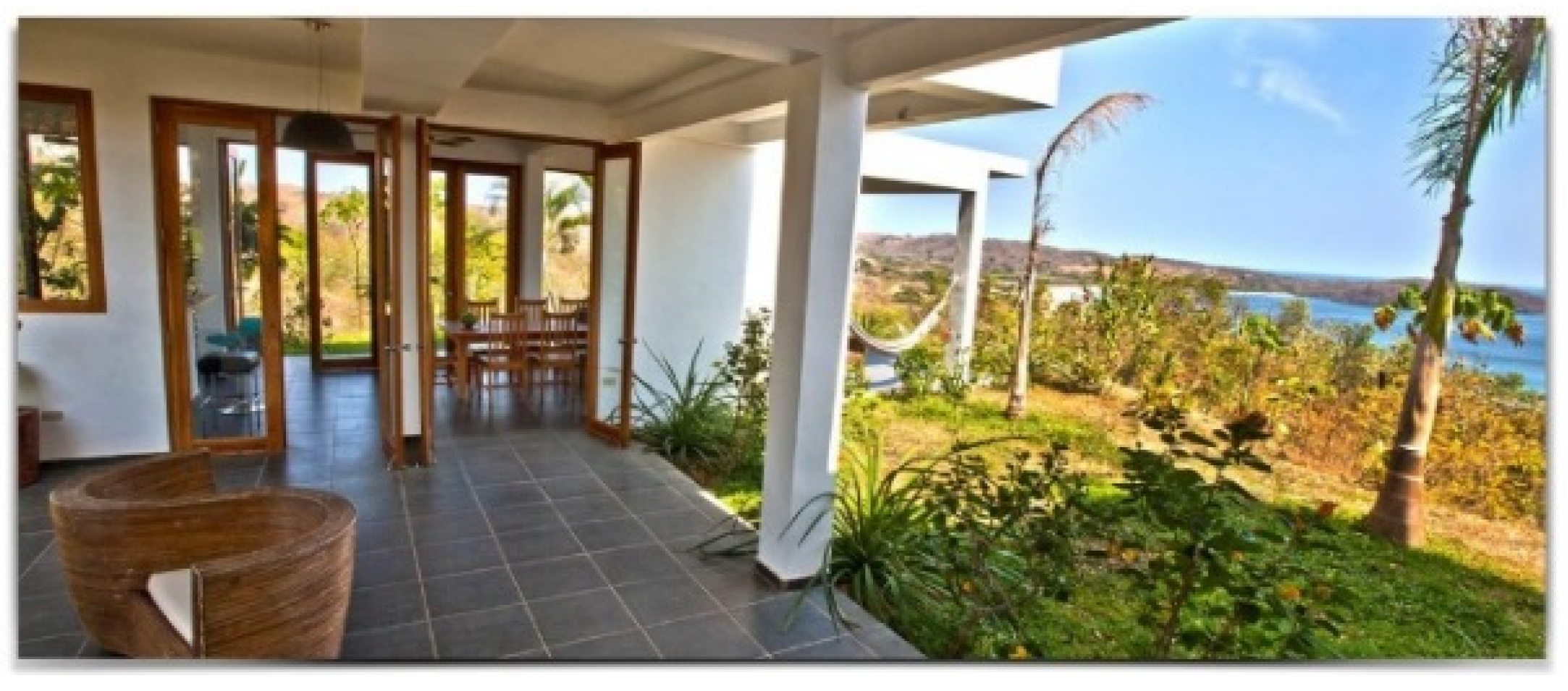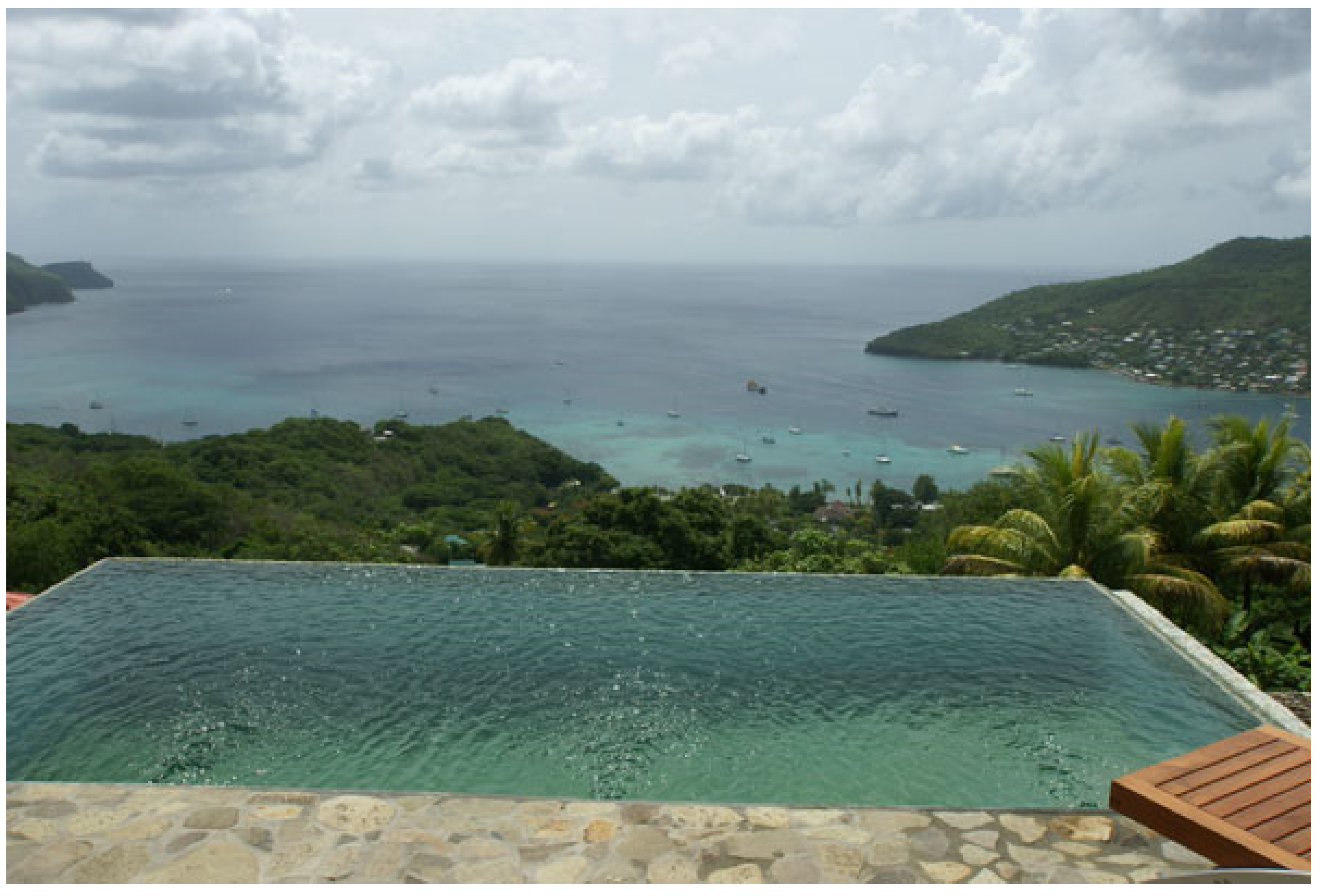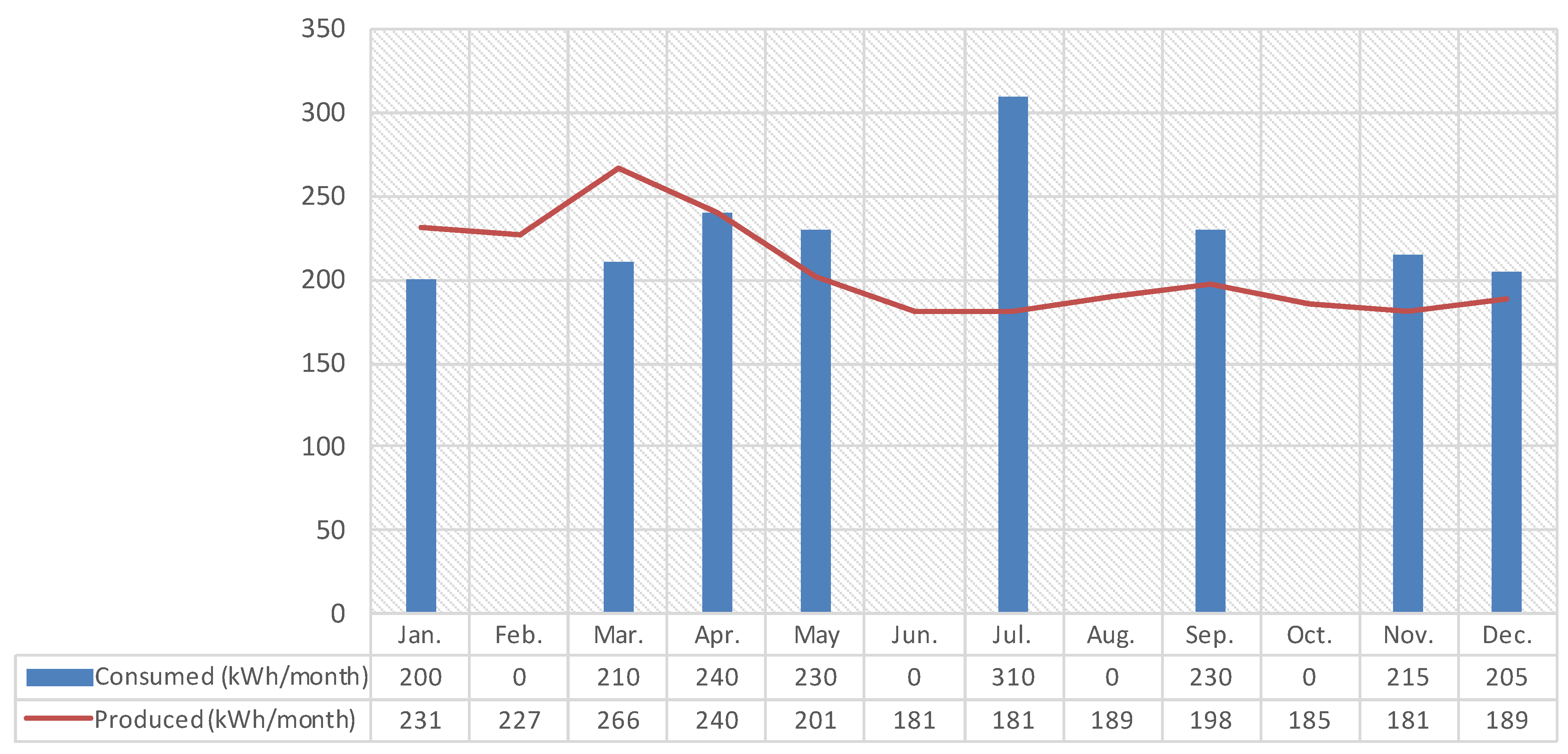Panama is booming. It has the highest economic growth rate in the hemisphere. Manufacturing, mining, utilities, and construction together account for 19% of GDP. Private construction is one of the key growth areas in Panama and new condominiums, hotels, and office towers are being built across the country [
14]. These buildings consume natural resources and energy.
The Espave House is a 2-story 213 m
2 post-and-beam structure on a 4.5 hectare lot adjacent to a 140 hectare reforestation pilot project. The building site is located between a hill and a valley and overlooks the Pacific Ocean to the south and south-east (
Figure 2a). The house has an open floor plan, 3 bedrooms, 3.5 bathrooms, living room, dining room, and kitchen (
Figure 2b).
The ratio of the southeast length to the northeast width is 1:2 to maximize both the view to the Pacific Ocean as well as the cooling breezes rising up from the ocean.
Table 1 presents the thermal properties of the building envelope. The windows are made of insulated glazing (
U-value = 1.1 W/m
2·K), the overall window
U-value is 1.40 W/m
2·K. The Solar Heat Gain Coefficient (SHGC) is 0.6. In addition to designing for passive cooling and daylighting, we installed photovoltaic panels to meet the electrical load, solar thermal to supply 100% of the domestic hot water load, and equipped it with energy efficient appliances.
Figure 2.
(a) View to the south-east from site, Playa Venao; (b) Plan of first and second floor.
There are three metrics that were adopted for this research: (1) Site Analysis, which is an examination of the home’s overall massing, spatial organization, and orientation; (2) Construction and Material Specifications, focusing on the materials and resources needed for its construction; and (3) Energy Analysis of its predicted system performance. The data was based on the narrative documents submitted by the owners during pre-design, emails/telephone conversations with the contractors and owners, and design and analysis documents created during the design/build phase.
2.1. Site Analysis
We analyzed the site with regard to wind and sun as well as storm water runoff to define building orientation, layout, massing, and footprint.
Figure 3 shows the site from the north, looking due south towards the Pacific Ocean.
Figure 3.
Photograph of the site where rectangular area indicates building area and dots represent location of wind anemometers which are mounted 1.5 m above the ground.
Figure 3.
Photograph of the site where rectangular area indicates building area and dots represent location of wind anemometers which are mounted 1.5 m above the ground.
Site mapping was an important first step in the design process given the sloping topography and wind conditions. We place wind anemometers at five locations on the site, mounted on a 1.5 m pole, shown on
Figure 3 (the black circles), around a rectangular area that would mark the general footprint of the building. We measured the wind speed and direction at 1.5 m above ground level to accommodate the height of openings for proposed windows in the house. The anemometer recorded hourly average wind speed and direction as well as air temperatures that were stored in a datalogger for two months (February and August), which mark height of the dry and wet seasons respectively. The wet season runs from March to December, and during this time cooler sea water temperatures (between 24 and 27 °C) prevail, but the warming effect of solar radiation is increasing to its maximum, resulting in air temperatures that can be >30 °C temperatures during the day. The winds during this season originate from the Pacific Ocean and rise up towards the site, from the southeast. Because the area between the ocean and the site has fairly dense growth (shrubbery and trees) and is along a slope, the wind speeds were light to moderate (10–15 km/h). To optimize passive cooling, we harnessed these breezes in the main public spaces of the house (terraces and great room). Cooling potential is increased by orienting openings towards the prevailing wind direction. We designed large openings to the southeast and smaller openings to the north, to promote cross ventilation. The dry season, which is from December to March, is less humid though average air temperatures are still high (~22–27 °C). On the site, winds during this season originated from the northeast and were fairly gusty (20–35 km/h), partially due to the lack of trees on the site to buffer the wind. Tree plantings, which are part of the site design strategy, would mitigate the northeastern wind effect. Nevertheless, we determined that these “dry” season winds from the northeast could not be utilized effectively for cooling and we recommended a shelterbelt on the northeastern slopes to buffer against their force.
We also conducted solar radiation analysis to maximize shading to improve passive cooling (
Figure 4). Our solar analysis, using a simple conceptual solar modeling tool, allowed us to examine the effect of solar radiation in the house at different times of the year and different times of the day. We analyzed the annual solar path diagram (shown in
Figure 4) for the altitude and azimuth of the sun. This diagram helped us to design the shading systems of the building. We were particularly interested in critical overheating periods (between July and September, when air temperatures peak), when shading the building would be essential to keep the interiors cool. The solar altitude for those three months of the year are between 77° and 83°, and we designed the overhangs to protect against direct solar penetration between 10 a.m. and 2 p.m. for those three months. The average daily maximum temperature during those three months is 32 °C, peaking between 10 a.m. and 2 p.m..
Figure 4.
Solar analysis of building using Ecotect solar tool.
Figure 4.
Solar analysis of building using Ecotect solar tool.
Building footprint as well as the relative usable area of the home was an equally important issue as size is one of the most significant contributing factors to the resource efficiency and the environmental impact of building construction activities [
15]. The main difference between Espave House and other vacation homes in the region is that the Espave House is almost 30% smaller, which accounts for significantly less materials and resources, both in construction and operation.
The spatial organization of the Espave House is optimized working daylight and passive cooling and ventilation. The home has an open floor plan with permeable walls along the southeastern side of the long axis that is mostly open to views of the ocean below. The house also utilizes very deep thresholds on the southeastern face that act as sun shades, allowing primarily indirect and diffuse light to the interior. As described previously, the deep overhangs (shown in
Figure 5a) prevent direct solar radiation from raising interior temperatures during the day. The recorded interior temperatures during the critical heating months averaged 5–7 degrees cooler than the maximum outdoor air temperature, with less than 1 degree variation from morning to evening. This suggests that the overhangs were effective in keeping the interiors protected against overheating, with cross ventilation further augmenting passive cooling. We did not calculate air exchange rates because the natural ventilation cooling strategy was a result of high exchange rate that varies depending on wind speed and direction, how many windows are open and whether the fans are on or not. This variability was part of our design, giving the occupants control over their comfort.
Figure 5.
(a) Southeastern elevation with deep overhangs to protect against direct solar gain; (b) Lighting analysis for daylight penetration in main space using Ecotect lighting tool.
Figure 5.
(a) Southeastern elevation with deep overhangs to protect against direct solar gain; (b) Lighting analysis for daylight penetration in main space using Ecotect lighting tool.
We used the daylighting tool from the conceptual model in Ecotect to examine whether the overhangs we designed would compromise the potential for natural light entering into the building. Our focus was to ensure that while direct solar radiation would not impact the interiors during the critical overheating months, there would still be enough diffuse natural light within the house to eliminate the need for artificial lighting during the daytime. For optimal daylight penetration, we created a shallow width of the house for allowing diffuse light from the south and southeast. This eliminates the need for artificial lighting during daylight hours (
Figure 5b). The image shows that for the main living space, natural daylight penetration is significant, with most of the living room area having a daylight factor between 0.5 and 0.7. The northeastern corner is the darkest part of the living space with a daylight factor of 0.12; this area is part of the kitchen counter, which would require task lighting for food preparation.
The northeastern side of the house is subject to very strong and gusty winds, which we harnessed to create cross-currents within the house for passive cooling. We designed slit windows with slated shades that can be adjusted according to ventilation needs. Because of this, the house does not need air conditioning except on the very hottest and most humid days in the year (typically in August and September). Even then, we installed the air conditioning only in the bedrooms where the cross ventilation strategy is limited due to privacy concerns. As a result, mechanical cooling is generally only used at night, when air temperatures and relative humidity may still be uncomfortably high.
We also worked with the reforestation program at Eco-Venao and mapped out a solution involving tree and shrub plantings to create a shelter belt along the entire eastern façade. The reforestation efforts have been on-going for the past twenty years, converting degraded and abandoned agriculture and pasture lands back into the tropical forests that used to flourish in this region. Studies of shelter belts have shown that trees can provide wind breaks to reduce wind speed and alter the characteristics of air flow around them. It is well-known that the structural characteristics of shelterbelts and the individual tree are important factors influencing their effectiveness [
16]. The shelterbelt we designed on the eastern side of the Espave House was composed of Acacia, Macano, Balo, Guácimo, Teak and Balsa trees. These are known to rapidly develop large, dense crowns and attained canopy closure after just two years [
17]. We also hope that these species can stabilize soils in what has now become eroded and infertile land.
In general, maintaining comfortable temperatures with passive strategies is difficult, because there are no controls to ensure the interior spaces do not overheat or over-ventilate. To prevent overheating, a simple massing technique is employed along with second floor overhangs and a light colored exterior to prevent mitigate heat gains. We designed deep thresholds with the flooring as a thermal mass element. The thermal mass in the threshold is locally sourced stone tiles that absorb heat during the day, creating a thermal break between the interior floor system and the exterior shaded space. The thermal mass absorbs the heat from the sun during the day—like a heat storage battery—and at night, radiates the heat back to the atmosphere. This 30 mm stone slab helps to regulate the temperature of the house at around 25 °C with little need for air conditioning (
Figure 6).
Figure 6.
Thermal mass stone slab.
Figure 6.
Thermal mass stone slab.
2.2. Material and Equipment Specifications
In the Espave House, using locally sourced and sustainably harvested materials and products was an imperative for minimizing embodied energy. Building and construction activities worldwide consume three billion tons of raw materials each year [
18] and sustainable building materials can help reduce the environmental impacts associated with extraction, transport, processing, fabrication, installation, reuse, recycling, and disposal. Furthermore, due to the close proximity of the Eco-resort which would provide an additional source of rent income for the owners, we considered how the building could promote the basic principles of those who vacation at Eco Venao- conservation and durability.
The Espave House walls are post-and-beam construction using sustainably harvested teak pressure-treated wood. In Panama, it is rare to construct walls out of wood, rather than concrete. But not only are wood walls cheaper to build, they have less embedded energy than concrete [
19]. Furthermore, teak is grown within 10 km from the site, whereas concrete would have to be transported from a town 300 km away. Other local materials such as glass countertops and sustainably harvested clay tiling further reduce embodied energy. In addition, all paints and finishes are low/no Volatile Organic Compounds (VOC), and the white-painted reflective metal roof is highly durable.
The Espave home’s exterior walls are constructed with light-colored materials that are punctuated with ventilation and/or window gaps to allow the interior to be passively daylit and ventilated. The mostly opaque walls on the north, east, and western facades are insulated with straw in the stud cavities, with a mixture of plasterboard and clay for sheathing. The entire wall assembly has an R-value of 3 K·m2/W (17 °F·ft2·h/BTU). The ceiling is insulated with fiberglass batts and has an R-value of 4 K·m2/W (23 °F·ft2·h/BTU). The roof is a metal deck that is painted white and reflective to help block radiative heat transfer. The roofing element is also from below ventilated to prevent heat transfer from its surface to the interior spaces. Double pane, low-e windows are used for additional energy efficiency. Whereas most homes in the area do not have any insulation and use jalousie windows that have no insulative or air sealing capacity at all, the Espave House outperforms its neighbors simply due to its construction specifications.
Moisture control is particularly important in the Panamanian climate and has a significant effect on building durability and occupant comfort. Bulk water (rain) penetration is controlled with well-placed down spouts and gutters to drain water away from the building, deep overhangs to keep water off the walls and windows, and free-draining building materials around the building perimeter. Free-draining materials such as crushed stone permits the flow of groundwater downwards and when properly installed, prevents water from collecting at the foundation walls and slab.
Due to an innovative passive dehumidification system, the Espave House can maintain the level of relative humidity around 50%–60% year-round. In conventional houses the relative humidity rises to about 70%–90% during the summer season. The side effects of higher humidity are reduced comfort and the energy it takes to cool and dehumidify interior spaces. Furthermore, a typical house absorbs hundreds of gallons of water during the summer months and cooling system has to do more work to dry the interior at considerable energy expense (2254 KJ/kg or 970 BTU/lb of water).
The passive dehumidification system for the Espave House is a cold water (
i.e., unheated) plunge pool in a small covered pavilion connected to the southern-eastern part of the house. The plunge pool is a bi-level four square meter outdoor “tub” that is designed to be like an outdoor hot tub (with 16 °C water) for relaxation and play (
Figure 7). The water from the plunge pool is significantly colder than the surrounding air temperature (which is between 24 and 32 °C), and serves a surface against which moisture from the humid air can condense. Ceiling fans and prevailing eastern winds help to circulate the cooled dehumidified air through open windows into the house.
Figure 7.
Plunge pool passive dehumidification system.
Figure 7.
Plunge pool passive dehumidification system.
2.3. Energy Analysis
The final design strategy towards net zero energy in the Espave House are the energy systems. This includes energy consuming equipment as well as the energy generation systems. The first consideration is to size the major equipment in the home correctly and select systems that are very efficient. That includes the air-conditioner and water heater as well as the duct and piping systems that deliver air and water to the outlets. The next opportunity to reduce energy loads is to use higher efficiency lighting and appliances. Once the home’s energy demand is reduced, a renewable energy production system (photovoltaics in this case) is installed to provide the electricity used in the home and offset electricity supplied by the utility when averaged over the course of one year. Because the home is not continuously occupied, we total annual energy loads are incomplete. However, we used monthly loads for the times when the house is occupied to ensure that overall annual energy expenditures were site net zero (
Figure 8). We found that the PV system was sufficient in January to mid-May. In July to December, the operational demand of the Espave house exceeded the PV production. The decision to install a battery subsystem to store reserve electrical energy during unoccupied periods. This battery subsystem ensured net positive energy production for the year.
In the Espave House, the owners worked to eliminate or find less energy intensive alternatives for major household appliances. For example, they also choose to use a solar-thermal hot water system rather than an electric hot water heater, as is common in the area. Appliances like the wall-mounted air conditioning unit, refrigerator, laundry machine, and dishwasher were all Energy Star-rated top-of-the-line American products. Almost all lighting in the house is florescent and plug loads are unplugged or put on a switched outlet strip.
The energy production system is a 2 KW PV system that generates electrical power. The PV is oriented due south to maximize yearly power output and achieve the lowest cost per watt. A 100-amp hour 48 volt battery pack can power the critical loads. For the home’s domestic water load, a solar hot water system using 110 evacuated glass tube collectors (112 square feet; 10 m2), coupled with a stainless steel hot water tank, and a circulator pump was installed. Once the tank has met the set point temperature, excess hot water from the collectors is used for the plunge pool, increasing the pool water temperature to a maximum of 20 °C.
Figure 8.
Average monthly energy consumed and produced in kilowatt-hours.
Figure 8.
Average monthly energy consumed and produced in kilowatt-hours.
